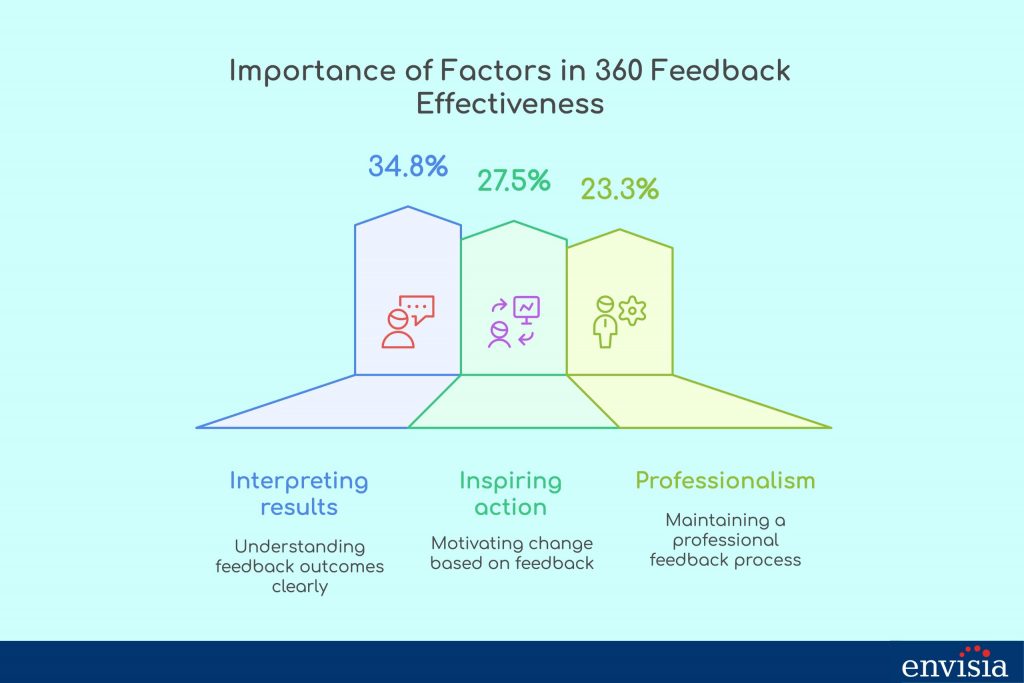360-degree feedback is a fundamental component of leadership growth and development. By gathering feedback from multiple perspectives—including one’s supervisor, peers, direct reports, and team members—this powerful tool provides a comprehensive view of a leader’s strengths and areas for improvement. However, the true value of 360 feedback results lies not just in collecting feedback but in effectively interpreting 360 feedback results to drive actionable change.
This guide to 360-degree feedback explores best practices for maximizing the impact of 360-degree assessments, ensuring feedback helps organizations foster a culture of continuous improvement. Drawing from Envisia Learning’s 30+ years of expertise in neuroscience-based leadership solutions, we’ll outline how to navigate the 360-degree feedback process for more effective results.
What Makes 360 Feedback Effective? Insights from Research
A seminal study by Robert Hooijberg and Nancy Lane (2009) surveyed 232 managers on what makes coaching effective. Participants highlighted three critical factors for feedback success:
- Interpreting results (34.8%)
- Inspiring action (27.5%)
- Professionalism (23.3%)
The majority of respondents emphasized that the best coaches could analyze strengths and weaknesses, clarify feedback data, and provide actionable feedback to drive leadership development. This aligns with Marshall Goldsmith’s concept of “feedforward,” which shifts focus from past mistakes to opportunities for improvement.

Key Takeaway
HR leaders and coaches must actively help leaders interpret 360-degree feedback results by balancing quantitative competency ratings with qualitative multi-rater feedback from multiple sources. This approach creates a meaningful development plan tailored to individual career development goals.
The Pitfalls of Poor Feedback Interpretation
Despite its advantages, a 360-degree feedback program can often be confusing if mishandled. Research by Smither and Walker (2004) found that leaders who received overwhelmingly negative comments experienced declines in performance due to disengagement or emotional distress. Neuroscience explains why: perceived criticism activates the same brain regions as physical pain, triggering defensiveness or withdrawal (Eisenberg et al., 2003).
Addressing Rater Discrepancies in 360-Degree Feedback
Rater discrepancies in 360-degree reviews are a common challenge, especially when self-ratings differ significantly from anonymous feedback provided by peers. This misalignment can create confusion and resistance to feedback. Using a structured framework like Envisia’s NeuroTeamView—a neuroscience-based approach to interpreting 360-degree feedback—can help reframe critical comments as opportunities for growth. When leaders shift their perspective in this way, they are more likely to strengthen collaboration, improve communication, and develop essential leadership skills.

Best Practices for Interpreting 360 Feedback Results
To ensure effective interpretation of 360-degree feedback reports, organizations should follow these best practices:
1. Contextualize the Data
- Compare Self-Ratings and Rater Feedback: Results and reviewer group differences often reveal blind spots. For example, a leader may rate themselves highly in “communication,” while feedback from peers highlights vague instructions.
- Analyze Rater Groups Separately: Differences between supervisor, peer, and direct report feedback can pinpoint key strengths and development needs.
- Focus on Core Competencies: Link feedback assessments to organizational competencies or behaviors critical for success.
2. Balance Strengths and Opportunities
- Highlight Strengths First: Starting with strengths makes it easy to build confidence. Envisia’s Leader TrustView tool helps leaders identify trust-building competencies.
- Frame Development Needs Constructively: Instead of “poor delegation,” reframe as “opportunities to empower team members.”
3. Bridge the Gap Between Insight and Action
- Create an Action Plan: Collaborate to prioritize 1–2 goals, such as improving feedback delivery to direct reports.
- Think of Specific Examples: Encourage participants to identify specific examples where behavioral changes can apply.
- Leverage Neuroscience: Envisia’s Talent Accelerator program uses habit-forming strategies to implement 360-degree feedback for lasting change.
Why 360-Degree Feedback Matters for Leadership Growth
When implemented effectively, a 360-degree feedback program can serve as a valuable tool for professional development and leadership growth. Some key benefits include:
- Enhancing Self-Awareness: Open feedback from multiple perspectives reduces bias and allows leaders to identify their strengths.
- Strengthening Leadership Skills: A well-structured feedback process identifies gaps in competencies like emotional intelligence or conflict resolution.
- Fostering a Culture of Continuous Improvement: Regular feedback cycles make growth a shared priority.
Studies have shown that well-implemented 360-degree feedback programs can lead to increased employee engagement and accelerated leadership development. For instance, research indicates that managers who received positive 360-degree feedback had lower turnover and higher service quality in their teams.
These findings suggest that 360-degree feedback can be a valuable tool for enhancing leadership skills and fostering a culture of continuous improvement.

Conclusion: Turning Feedback into a Catalyst for Change
Interpreting 360 feedback results isn’t just about analyzing a 360-degree assessment—it’s about guiding leaders from insight to action while mitigating emotional pitfalls. By focusing on strengths, framing feedback constructively, and aligning development plans with organizational goals, HR leaders and coaches can transform 360 assessments into a powerful development tool.
Envisia Learning’s suite of neuroscience-backed tools—from customizable 360-degree feedback programs to stress management assessments—helps organizations turn 360 feedback results into measurable behavior change. Contact us today to enhance your feedback program and drive real leadership development improvements.
